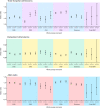Clinical and financial burden of hospitalised community-acquired pneumonia in patients with selected underlying comorbidities in England
- PMID: 33051218
- PMCID: PMC7555110
- DOI: 10.1136/bmjresp-2020-000703
Clinical and financial burden of hospitalised community-acquired pneumonia in patients with selected underlying comorbidities in England
Abstract
Background: Hospitalised pneumonia may have long-term clinical and financial impact in adult patients with underlying comorbidities.
Methods: We conducted a retrospective cohort study using the Hospital Episode Statistics (HES) database to determine the clinical and financial burden over 3 years of hospitalised community-acquired pneumonia (CAP) to England's National Health Service (NHS). Subjects were adults with six underlying comorbidities (chronic heart disease (CHD); chronic kidney disease (CKD); chronic liver disease (CLD); chronic respiratory disease (CRD); diabetes mellitus (DM) and post bone marrow transplant (post-BMT)) with an inpatient admission in 2012/2013. Patients with CAP in 2013/2014 were followed for 3 years and compared with similarly aged, propensity score-matched adults with the same comorbidity without CAP.
Findings: The RR of hospital admissions increased after CAP, ranging from 1.08 (95% CI 1.04 to 1.12) for CKD to 1.38 (95% CI 1.35 to 1.40) for CRD. This increase was maintained for at least 2 years. Mean difference in hospital healthcare costs (£) was higher for CAP patients in 2013/2014; ranging from £1115 for DM to £8444 for BMT, and remained higher for 4/6 groups for 2 more years, ranging from £1907 (95% CI £1573 to £2240) for DM to £11 167 (95% CI £10 847 to £11 486) for CRD.) The OR for mortality was significantly higher for at least 3 years after CAP, ranging from 4.76 (95% CI 4.12 to 5.51, p<0.0001) for CLD to 7.50 (95%CI 4.71 to 11.92, p<0.0001) for BMT.
Interpretation: For patients with selected underlying comorbidities, healthcare utilisation, costs and mortality increase for at least 3 years after being hospitalised CAP.
Keywords: pneumonia; respiratory infection.
© Author(s) (or their employer(s)) 2020. Re-use permitted under CC BY-NC. No commercial re-use. See rights and permissions. Published by BMJ.
Conflict of interest statement
Competing interests: All authors have completed the International Committee of Medical Journal Editors uniform disclosure form at www.icmje.org/coi_disclosure.pdf and declare the following: JDC has received research grant support from AstraZeneca, Pfizer, GlaxoSmithKline, Boehringer Ingelheim and Bayer Healthcare and has participated in advisory boards or lectures for Griffols, AstraZeneca, Pfizer, Napp, Boehringer Ingelheim and Bayer Healthcare. He also received remuneration from Pfizer for services as a member of the Steering Committee for this study. MS has received personal fees from GSK, Pfizer, AstraZeneca and Sanofi Pasteur as a speaker at international meetings and as a member of advisory boards (outside the scope of the submitted work). She has also worked as a contractor for Pfizer and received remuneration from Pfizer for services as a member of the Steering Committee for this study. JC, DJ, QJ, AV, GE and HM are full-time employees and shareholders of Pfizer; no other relationships or activities that could appear to have influenced the submitted work. APJR reports other from Health iQ and grants from Pfizer, outside the submitted work; and at the present time, I am providing consultancy work to Health iQ Ltd (UK), which works with clients across the life sciences industry.
Figures



References
Publication types
MeSH terms
LinkOut - more resources
Full Text Sources
Medical
Miscellaneous
